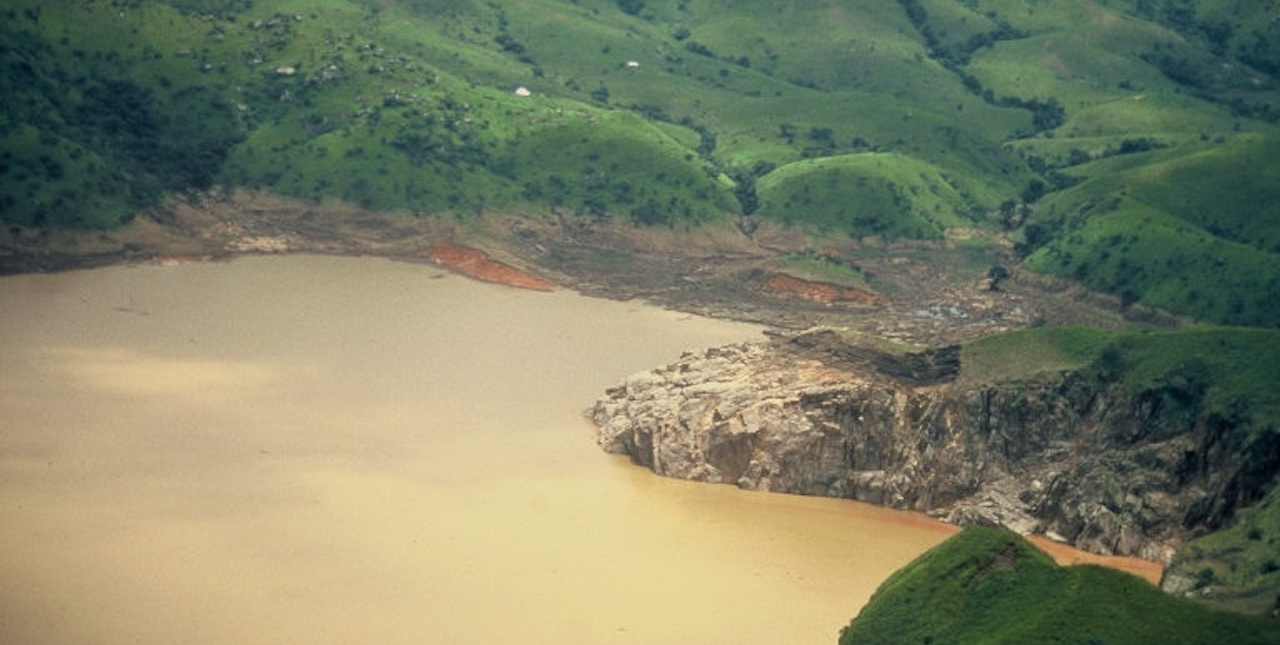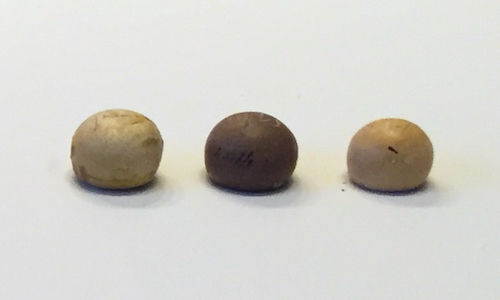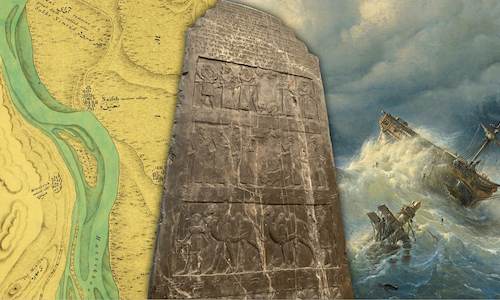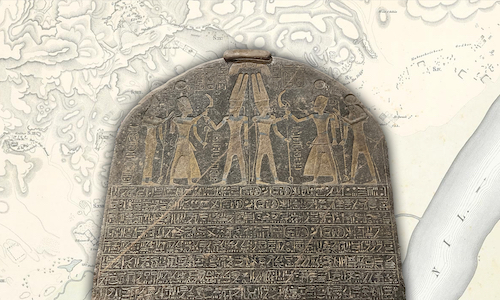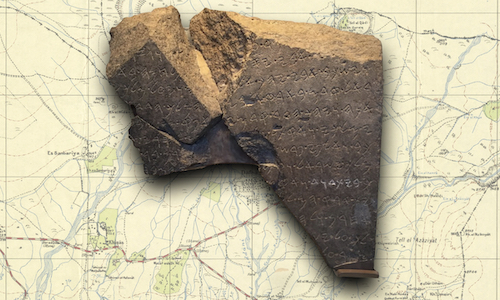A critical assessment of the scientific explanation for the Ten Plagues in “The Exodus Decoded” – Lake Nyos and the First Plague
In some corners of the Christian world the need to read Exodus literally has created a market for books and documentaries that explain how the events recorded in its pages happened. While they’re usually visually stunning and persuasive to the uninformed, these resources package up fringe theories, out-of-context quotes from scholars, and fabricated connections between archaeological artefacts and ancient texts that quite plainly don’t exist.
The documentaries are invariably sloppy with their chronologies. They claim that long studied texts and oft visited sites are “unknown until now”. They treat the bible like it’s some sort of clue book for a grand puzzle.
In the space of an hour and thirty minutes the documentary maker takes the audience on an Indiana Jones-style adventure from “no one knows anything” to “we’ve solved everything, what do you think?”
It’s worth spelling out the unspoken schema these Exodus documentaries follow:
For centuries, godless scholars who want to destroy the Bible’s credibility have misinterpreted archaeological evidence and ancient texts. But now, I, a documentary maker, have for the first time correctly interpreted the relevant data, and produced a coherent big picture that both overturns everything that’s been written on the Exodus and proves that the event happened as written. This whole time the answers were staring us in the face.
Reading proper scholarship is infinitely preferable to watching these nonsense documentaries, but since naive-but-well-intentioned Christian friends keep asking me about the claims they’ve encountered in these videos, I’ve had to watch some of them.
I could spend the rest of my life eviscerating these books and documentaries, but my mental health matters. So I’ve decided to write a series on one section of one documentary in the hope that the exercise shows just how little critical thinking is required to debunk them.
The example we’re going to look at is the “scientific explanation” of the ten plagues found in Simcha Jacobovici’s 2006 The Exodus Decoded (‘ED’ from here on in). It ticks all the boxes.
Introducing the Ten Plagues
To get to the point in the documentary where the “comprehensive scientific explanation for all ten plagues” begins to be explained (around 32 mins 14 seconds) the audience has already been on quite a journey.
Though it makes me twitch, we’re going to accept the identification of the ultimate cause of the plague sequence with the Thera (Santorini) eruption.
We’re going to put aside the ongoing heated discussion around the dating of that event, and brush aside its implications for the validity of the documentary’s claims. We’re going to accept as fact the patently false chronology the documentary is based on1 and deal purely with what it has to say about the plagues. We’re also going to be ignoring all the fine work that’s been done over the years on source and redaction criticism of the plague narratives. Finally, we’ll proceed with the fundamentalist assumption that Moses wrote these narratives in a single document.
Jacobovici begins his section on the plagues as follows:
Until now, no one has come up with a comprehensive scientific explanation for all ten plagues.
OK. Let’s start by making careful note of the precise claim: we’re apparently going to be presented with scientific explanations for the events described in scripture. If we’re at all familiar with the relevant scholarship we’ll recognise that Jacobovici is in deep, deep trouble. As William Propp explains,
Any rigorous attempt to explain the whole Plagues narrative as a naive but basically accurate report of a chain of natural calamities is doomed from the start.2
Regardless, let’s wade right in.
We’re going to look at Jacobovici’s claims from a few angles:
- Is the “scientific explanation” he presents scientifically sound?
- Do the “scientifically explained” phenomena match scripture’s description of the relevant plague?
- Does the “scientific explanation” marry up with the biblical timeline of the plagues sequence?
For that last one, we’re going to need to know how long scripture says the ten plagues took to unfold…
A biblical timeline of the plagues
Though the Exodus record doesn’t spell out how long the duration of all ten plagues was, we are given the period of a few of the intervals between some of the plagues:
- Exodus 7:25 tells us that between the start of plague 1 & 2 were seven days.
- Ex 8:10 indicates that the plague of frogs lasted at least a couple of days (“tomorrow”)
- Ex 8:20 says that on day 1 of the fourth plague Pharaoh was threatened with a plague of flies, 8:24 says that God was true to his word and sent the flies, 8:29&31 says that God removed the flies the next day. So, 3 days all up.
- Ex 9:31 says that the hail ruined the flax and barley that were “in the ear”. In Egypt barley is harvested in February/early March.3
- Ex 10:1-13 has Moses conversing with Pharaoh, and the east wind beginning that would bring the locusts. Ex 10:13 says the locusts arrived the next morning. Ex 10:16 has Pharaoh “hurriedly” call Moses, who in Ex 10:18 prays to God who in Ex 10:19 arranges for a westerly wind that blows the locusts into the Red Sea – so, at least a couple of days.
- Ex 10:22 has the plague of darkness lasting 3 days.
- Ex 12:17-18 says that the Israelites left Egypt on the 14th day of the first month. Ex 13:4 says that the month was Abib. Passover happens in late March-April.4
When all of that is added up we have a plague sequence lasting at least two months. It’s probably unwise to extrapolate out the 6 week gap between the 7th plague of hail and the 10th plague of the death of the first born to a period of 6 months or so. We can safely proceed on the basis that the Exodus record has the 10 plagues taking a minimum of 2 months to unfold. With that, let’s take a look at the plagues themselves.
Plague 1 – Water to blood
God instructed Moses to visit Pharaoh and speak to him “as he is going out to the water” (Ex 7:15). In the sight of Pharaoh and his officials (Ex 7:20), Moses, standing on the river bank (Ex 7:15) with Aaron, lifted up his staff. The water in the river then turned to blood, Pharaoh seemingly still standing in it. But it wasn’t just the river that turned to blood; it was the water in Egypt’s “rivers, its canals, and its ponds, and all its pools of water… even in vessels of wood and in vessels of stone” (Ex 7:19). Pharaoh remained undeterred however as his magicians were able to demonstrate the same feat (Ex 7:22).
What is Jacobovici’s explanation for this first plague? He claims that the water turning to blood is the first in a series of knock-on effects from an “earthquake storm” that accompanied the Thera eruption:
Earthquakes can’t possibly explain how Moses turned the Nile’s waters into blood, can they? In fact they can, when they trigger gas leaks; and we don’t have to go back 3,500 years to prove the point. In 1984, at Lake Monoun, and in 1986 at Lake Nyos, both in Cameroon, the sweet clear lake waters suddenly turned blood-red. The mystery was solved when Professor George Kling explained the phenomenon in terms of an underground gas leak.
With this, the documentary turns its attention to the 1986 Lake Nyos disaster. This tragic event is employed to explain the first plague as well as the nine that followed, so it’s worth spending a bit of time getting familiar with it.
The Lake Nyos disaster
The ‘gas leak’ Jacobovici mentions is West Africa’s worst natural disaster on record.5 It resulted in the deaths of 1700 people, and the displacement and resettlement in seven camps of 4424 more.6 The loss to animal life was also enormous: by one estimate 3952 cows, 552 goats, 337 sheep and 3404 fowl also died.7
Here’s how the Cameroonian catastrophe was described by Professor George Kling in one of the first published accounts of the events of the day, in the journal Science the following year:
On 21 August at about 2130 a series of rumbling sounds lasting perhaps 15 to 20 seconds caused people in the immediate area of the lake to come out of their homes. One observer reported hearing a bubbling sound, and after walking to a vantage point he saw a white cloud rise from the lake and a large water surge. Many people smelled the odor of rotten eggs or gunpowder, experienced a warm sensation, and rapidly lost consciousness. Survivors of the incident, who awakened from 6 to 36 hours later, felt weak and confused. Many found that their oil lamps had gone out, although they still contained oil, and that their animals and family members were dead. The bird, insect, and small mammal populations in the area were not seen for at least 48 hours after the event. The plant life was essentially unaffected.8
It turns out that Lake Nyos sits in a volcanic crater formed around 400 years ago.9 Beneath its 208m depth10 lies a diatreme – a volcanic pipe, formed by a gas explosion, that runs down to the magma.11
Carbon Dioxide and its effects
Along with other volcanic gases, Carbon Dioxide (CO2) slowly makes its way up the diatreme beneath the lake. When it reaches the lake it doesn’t bubble up to the surface as you might expect; instead, it dissolves into the water. The dissolved gas isn’t distributed evenly throughout the lake; it remains at the bottom in a layer called the hypolimnion.12 There it sits, building up and up and up until the water is saturated with CO2. To give an idea of just how much CO2 can be dissolved in lake water, in measurements taken after the event there were still 5 litres of CO2 in every 1 litre of water.13
It should be noted that this situation can only occur in crater lakes:
Only large deep lakes can contain potentially hazardous quantities of dissolved gas… any lake which is less than about 30 metres deep is likely to be well oxygenated and therefore contain very little dissolved carbon dioxide.”14
The circumstances under which this scenario can occur are clearly limited.
The Lake Nyos disaster was caused by the release of CO2 from the lake. The CO2 degassed and effervesced from the bottom of the lake over the course of a few hours15 taking 200,000 tonnes of water16 out of the lake with it. It created an invisible cloud of CO2 that was, at least initially, 100 metres high over the crater rim.17 As the gas cloud spilled over the rim and headed toward the village of Nyos at a speed of 19m/s18 it thinned out to 50 metres high, and then, over the course of the next few hours, dissipated without a trace.19
Baxter and Kapila wrote up a summary of the health impacts of the gas on both the 1700+ who died in the disaster, and the 845 survivors who were treated in nearby hospitals.20
From Catholic missionaries who were in the area at the time they received reports of the discovery of human and animal corpses over an area 20 km long and 15 km wide. All the deaths occurred in the valley bottoms. The evidence suggests the vast majority of those who died lost consciousness very quickly: they lay dead on their beds or had managed to make it only a short way from their houses.21
Most of the corpses looked normal. A few had skin lesions that looked like burns, and blisters 5-15 cm wide.22 Of the survivors, 19% had skin lesions23, these were mostly on the cheekbone area of the face and other pressure points along with areas of poor circulation, like the shins, suggesting their wounds were sustained on falling over as they lost consciousness.24
Those who lost consciousness but eventually woke up did so after a very long time spent unconscious – up to 36 hours in some cases. They reported that before blacking out they felt fatigue, light-headedness, warmth, and confusion.25
Dissolved iron and its effects
As well as containing large amounts of dissolved CO2, Lake Nyos’ hypolimnion also contained a large amount of dissolved iron. When the dissolved iron, drawn upward by the CO2, reached a depth of 10 metres from the surface, it mixed with the oxygenated waters it encountered. The mix of dissolved iron and oxygen caused a chemical reaction to take place producing iron hydroxide, i.e. rust.26 This rust gave the surface layer27 of the lake a colour variously described as “reddish”,28 “dull red”29, “reddish-brown”,30 and “brown”31. Photographs of the lake show it to be far from the colour of blood.
The 14 seismograph stations installed between 1984 and 1985 to monitor the seismic activity of Mt Cameroon detected plenty of earthquakes so minor they could not be felt32, however they didn’t detect any significant seismic activity during or preceding the disaster.33 Though ultimately “what disturbed the lake’s stable stratification in 1986 can never be known for certain”,34 and there’s plenty of discussion about what triggered the release of CO2 from the lake, it’s widely agreed that the disaster was not caused by an earthquake.
We could go into significantly more detail, but that’s more than enough to decide just how useful the Lake Nyos disaster is as an explanation for the first plague described in Exodus 7.
The first plague in light of the Lake Nyos disaster
As it turns out, an interview with Professor George Kling whose work we’ve been citing makes up a significant portion of the documentary’s explanation for the first plague. Here’s what he has to say:
When it comes to the biblical plagues along the Nile Delta there, there are many elements that are present that could suggest a buildup of gas. So we could have a situation where gas beneath the earth is trapped in pockets, and earthquakes along the fault line then release that gas; and depending on the kind of water that that gas goes through, it could even turn that water red.
The interview is overlaid with a fair bit of B-Roll of bubbling water and shots of Lake Nyos, so it’s hard to be sure that Kling has been fairly represented. We’ll proceed on the assumption that the interview was played as recorded, not chopped and spliced together.
Does Kling’s suggested possible explanation for the 1st plague work?
In a word, no.
Scientific objections
For the example of Lake Nyos to be relevant we’d need the Nile to be stratified into at least two layers – an oxygenated surface layer and a lower layer containing no oxygen but loads of dissolved iron. Does the Nile resemble this? Not at all.
A 2009 study sampled various locations along a 60 km long stretch of the Nile, south and north of Cairo, including just outside an iron and steel factory.35 They did find that the amount of iron in the river was higher than it should be36, but that iron “exists as crystalline iron oxides (goethite, limonite, and magnetite)”37; not the kind of iron that turns to rust when it encounters oxygenated water.
So much for the iron content. Even if there was enough dissolved iron, is the Nile deep enough for the Nyos scenario? An investigation of the river’s last 150 km before it meets the sea found that its average depth was around 8 metres; its deepest point being 18 metres below the surface.38 That’s nowhere near the minimum 30 metres of depth required to have a non-oxygenated lake, never mind flowing river.
How about a fault line that crosses the river that a pocket of CO2 could come bubbling up through? Do any of those exist? As Jacobovici explains,
The Nile Delta where the Bible says the exodus took place is criss-crossed by fault lines. To the east the Great Rift Fault separating the Asian and African plates runs through the Sea of Galilee, the Dead Sea, and the Red Sea, all the way to Africa. In addition there is a fault line that runs along the modern Suez Canal and another fault line that runs along the Nile Delta under ancient Avaris. Meanwhile, some 700 kilometres to the west, the rift between the African plate and the European plate runs practically under Santorini.
The area certainly is seismically active, but the criteria for the scenario suggested in the documentary are a little more stringent. It requires not just an earthquake – we also need the Nile to be crossed by a fault line; somewhere for the released CO2 to meet the river water (and disturb the non-existent dissolved iron in the river’s non-existent non-oxygenated bottom layer).
Does such a fault line exist? Yes. There are a few Cretaceous–Early Tertiary faults that cross the Nile in the Cairo area.39

But, things aren’t that easy. An oft-overlooked aspect of this plague is that, as Ex 7:21 explains, the water turning to blood happened not just in the area around Goshen in northern Egypt but “throughout the whole land of Egypt”.
All the water in all of Egypt turned reddish-brown.
Clearly, CO2 bubbling up through fault lines near Cairo isn’t going to disturb supposedly iron-rich waters around 1,000 kilometres upstream at ancient Egypt’s southern border at the first cataract at Aswan. But if Jacobovici’s “comprehensive scientific explanation” is to explain what we read in the Exodus record, it needs to explain how water at Egypt’s southern border turned reddish-brown. For that we would need a fault line that runs beneath the Nile just south of modern Aswan.
Though there are seismically active faults in the area40 –quite a number of them in fact41– none of the fault lines run beneath the river. The fault lines stop a few kilometres short at the edge of Lake Nasser. That being the case, there’s nowhere for CO2 to bubble up from under the river and cause the non-existent dissolved iron to leave the non-existent non-oxygenated bottom layer of the Nile and meet the topmost oxygenated later, thus forming iron oxide to give the river a reddish-brown appearance. Bearing in mind that all of Egypt’s water was said to have turned to blood, the bubbling CO2’s disturbance of the non-oxygenated layer of water at Aswan would need to stir up the non-existent iron-rich water layer the entire 1,000 km length of the Nile from this point.
Jacobovici’s explanation has another difficulty: the implications of what we find in the biblical time period. As we’ve seen above, in Exodus 7:25 there were seven days between the 1st plague and Moses’ visit to Pharaoh to warn him of the 2nd plague. If, as is commonly assumed, the river was no longer reddish-brown by the time of the second plague, then the reddish-brown water at Egypt’s southern border would need to flow down the Nile and out into the Mediterranean in a maximum of seven days. And because the Egyptian magicians were said to replicate the miracle, this would actually need to happen twice in the same seven day period. This raises the obvious question: how long does it take water in the Nile at Aswan to reach the Mediterranean?
Since the Aswan High Dam was built, the stretch of the Nile from Aswan to the sea no longer behaves quite as it used to, so we can’t pretend to know exactly how fast it used to flow. Also, far more water is drawn out of the Nile for thirsty mouths and irrigation than used to be the case. As a result, we can’t be all that precise about the Nile’s flow velocity in antiquity.
We do have the modern figures to work with though. A recent study that took readings at different points along the Nile explains that,
“The mean flow velocity varied from 0.32 to 0.75 m/s”42
Based on that we can work out that it takes between ~15.5 and ~36 days for water to flow between Egypt’s southern border at Aswan and the Mediterranean sea.43
Working on the assumption that the Nile’s current average mean flow velocity isn’t totally incomparable with how it used to be in antiquity, it’s pretty clear that there’s no way that reddish-brown water at Egypt’s southern border at Aswan would have flowed down the Nile and out to sea – twice – in the space of a week. Even at the top average speed it would have taken more than 2 weeks for the river to clear before the magicians could repeat the trick in any convincing way (it’s hard to convince anyone you’ve changed water from clear to reddish-brown if the water is already reddish-brown from a previous instance of the same phenomenon – they would need to turn clear water reddish-brown to be taken seriously).
To put it politely, it seems unlikely that the scenario painted in the documentary could produce a reddish-brown Nile that matches the biblical description.
Putting together all of the above, we would need a non-oxygenated layer of an 8 metre deep river to contain a very large amount of dissolved iron magically standing still against the river current, precisely over one of the two or three fault lines that cross the Nile in the Cairo area and the fault lines that we’re going to pretend exist at Aswan, and everywhere in between these two points. The CO2 bubbling up through these fault lines would then unfreeze the still-standing dissolved iron, causing the river to give it a rusty colour. Since there are 7 days between the 1st and 2nd plague and the Egyptian magicians replicated the plague, the Nile would need to flow more than 4 times faster than its top average speed in order to flush all the reddish-brown water out to sea with enough time for the magicians to replicate the plague and cause all the water in Egypt to turn reddish-brown, and be flushed out in time for the 2nd plague.
Seems legit.
Biblical objections
Let’s pretend the scientific impossibilities inherent in Jacobovici’s scientific explanation aren’t insurmountable. There is a bigger problem his suggested solution has to face: it doesn’t explain all the phenomena described in the bible – far from it. Let’s remind ourselves of how he sets up the plague sequence:
Earthquakes can’t possibly explain how Moses turned the Nile’s waters into blood, can they? … If the Nile turned blood-red as a result of a gas leak, then the chain of events described in the Bible would have been set into motion.
Hopefully the goal post shifting is clear – the above quote contains two instances of the logical fallacy.
Jacobovici asks “Earthquakes can’t possibly explain how Moses turned the Nile’s waters into blood, can they?” He’s preparing the audience for an explanation of how the Nile could have turned to blood. But contrast this with what we read in scripture:
Ex 7:19 The LORD said to Moses, “Say to Aaron, ‘Take your staff and stretch out your hand over the waters of Egypt—over its rivers, its canals, and its ponds, and all its pools of water—so that they may become blood; and there shall be blood throughout the whole land of Egypt, even in vessels of wood and in vessels of stone.’”
The biblical record states that the plague didn’t affect only the Nile and the canals connected to it; the ponds and water jars were affected too. It should be pretty obvious that CO2-bubble-induced disturbances of the Nile won’t have any affect on pond water, never mind the contents of water jars.
Let’s have the same quote again so we can call out the second instance of goal-post-shifting:
Earthquakes can’t possibly explain how Moses turned the Nile’s waters into blood, can they? … If the Nile turned blood-red as a result of a gas leak, then the chain of events described in the Bible would have been set into motion.
He starts by wondering if an earthquake could somehow cause the Nile to turn into blood. In the next sentence he changes that to the Nile turning blood-red.
Notice that? He’s gone from looking for an explanation for a change in substance, i.e. water to blood, to now looking for an explanation for a change in the Nile water’s appearance, i.e. “the sweet clear lake waters suddenly turning blood-red”.
The biblical text is abundantly clear: its claim is that the water actually turned into actual blood. Not “blood-red”. Scripture describes a change of substance, not just appearance. The goal posts have been more than just shifted; they’ve been picked up and taken on a hike.
In conclusion, Jacobovici’s explanation of the first plague is nonsense, from both a scientific and biblical point of view – it’s not physically possible, and even it if was, it doesn’t explain what’s written in the text.
Awkward segue
Having seen that the “comprehensive scientific explanation” for the first plague is anything but comprehensive or scientific, we turn to the implications of what Jacobovici says straight after George Kling’s clip:
If the Nile turned blood-red as a result of a gas leak, then the chain of events described in the Bible would have been set into motion.
With that opening “if”, Jacobovici’s explanation for the 10 plagues fails its own test. The “explanation” is self-debunking.
However, for the purposes of this series, we’re going to pretend that that the first plague happened exactly as he says it did, and that it really did cause the nine plagues that followed in the biblical account.
Yes, that’s impossible. Yes, it doesn’t make any sense. Yes, we could justifiably stop flogging this dead horse… but where’s the fun in that?
In the next post we’ll continue with the new few plagues.
Further reading
- Dr Seuss, Green Eggs and Ham - it would be a more profitable use of your time than watching The Exodus Decoded.
Featured image
Public domain. Taken by Jack Lockwood of the United States Geological Survey. Source: https://www.usgs.gov/media/images/exploding-lakes-cameroon-0
Footnotes
-
Those who know me will inform you that chronological jiggery pokery [Hulk voice:] makes me angry. Accepting a nonsense chronology even for the purposes of ripping another argument limb from limb makes me twitch. E.g. Jacobovici claims that the ten plagues were the result of the Thera eruption dated to 1628 BCE, but that the Exodus was the expulsion of the Hyksos that took place under Pharaoh Ahmose I who only began to rule in 1550 BCE at the beginning of the New Kingdom. For an introduction to the chronological difficulties surrounding these events see Janine Bourriau, “The Second Intermediate Period (c.1650-1550 BC),” in The Oxford Dictionary of Ancient Egypt, ed. Ian Shaw (Oxford University Press, 2000), 205. ↩
-
William H. C. Propp, Exodus 1–18: A New Translation with Introduction and Commentary, vol. 2, Anchor Yale Bible (New Haven; London: Yale University Press, 2008), 347. ↩
-
“The Elohist has not lost track of the calendar. He is thinking in terms of the Egyptian agricultural year, where crops ripen earlier than in Canaan. Egyptian flax blooms and barley is harvested in February or early March, while Palestine begins to reap its barley in April, the month of ʾābîb. Similarly, the locusts destroy Egypt’s wheat crop shortly before the harvest in March–April, roughly the time of the Exodus and the season in which locusts are common. Canaan’s wheat is reaped in May.” William H. C. Propp, Exodus 1–18: A New Translation with Introduction and Commentary, vol. 2, Anchor Yale Bible (New Haven; London: Yale University Press, 2008), 335. ↩
-
“The Elohist has not lost track of the calendar. He is thinking in terms of the Egyptian agricultural year, where crops ripen earlier than in Canaan. Egyptian flax blooms and barley is harvested in February or early March, while Palestine begins to reap its barley in April, the month of ʾābîb. Similarly, the locusts destroy Egypt’s wheat crop shortly before the harvest in March–April, roughly the time of the Exodus and the season in which locusts are common. Canaan’s wheat is reaped in May.” William H. C. Propp, Exodus 1–18: A New Translation with Introduction and Commentary, vol. 2, Anchor Yale Bible (New Haven; London: Yale University Press, 2008), 335. ↩
-
“The worst natural disaster ever to be inflicted on West Africa by a single catastrophic event was caused by a cloud of toxic gas, released from the waters of Lake Nyos on the 21 st August 1986” Samuel J. Freeth, “An introduction to the natural hazards of West and Central Africa,” in Natural Hazards In West and Central Africa, eds. Samuel J. Freeth, Charles O. Ofoegbu K. Mosto Onuoha (Vieweg, 1992), 4. ↩
-
Mesmin Tchindjang, “Lake Nyos, a Multirisk and Vulnerability Appraisal,” Geosciences (August), Vol. 8, No 312. (2018), 10. DOI: 10.3390/geosciences8090312 ↩
-
Samuel J. Freeth, “The Lake Nyos Disaster,” in Natural Hazards In West and Central Africa, eds. Samuel J. Freeth, Charles O. Ofoegbu K. Mosto Onuoha (Vieweg, 1992), 66. ↩
-
George W. Kling et al, “The 1986 Lake Nyos Gas Disaster in Cameroon, West Africa,” Science (April) Vol. 236, No. 4798 (1987), 169. DOI: 10.1126/science.236.4798.169 ↩
-
John P. Lockwood and Meyer Rubin, “Origin and age of the Lake Nyos maar, Cameroon,” Journal of Volcanology and Geothermal Research (Nov), Vol. 39, No. 2-3 (1989), 123. DOI: 10.1016/0377-0273(89)90052-8 ↩
-
Ibid., 119. ↩
-
Ibid., 120. ↩
-
Kling 1987, op. cit., 173. ↩
-
Ibid., 171. ↩
-
Samuel J. Freeth, “Potentially hazardous lakes in West Africa,” in Natural Hazards In West and Central Africa, eds. Samuel J. Freeth, Charles O. Ofoegbu K. Mosto Onuoha (Vieweg, 1992), 47. ↩
-
Sei-Ichi Kanari, “An inference on the process of gas outburst from Lake Nyos, Cameroon,” Journal of Volcanology and Geothermal Research (Nov), Vol. 39, No. 2-3 (1989), 147-149. DOI: 10.1016/0377-0273(89)90054-1 ↩
-
Freeth 1992, op. cit., 69. ↩
-
Kling 1987, op. cit., 173. ↩
-
Sei-Ichi Kanari 1989, op. cit., 135. ↩
-
Kling 1987, op. cit., 173. ↩
-
Peter J. Baxter and Mukesh Kapila, “Acute health impact of the gas release at Lake Nyos, Cameroon, 1986,” Journal of Volcanology and Geothermal Research (Nov), Vol. 39, No. 2-3 (1989). DOI: 10.1016/0377-0273(89)90064-4 ↩
-
Ibid., 266-267. ↩
-
Ibid., 268. ↩
-
Ibid., 269. ↩
-
Ibid., 270. ↩
-
Kling 1987, op. cit., 173-174. ↩
-
George W. Kling, Michele L. Tuttle, and William C. Evans, “The evolution of thermal structure and water chemistry in Lake Nyos,” Journal of Volcanology and Geothermal Research (Nov), Vol. 39, No. 2-3 (1989), 159. DOI: 10.1016/0377-0273(89)90055-3 ↩
-
A.B. Walker, D.W. Redmayne and C.W.A. Browitt, “Seismic monitoring of Lake Nyos, Cameroon,” in Natural Hazards In West and Central Africa, eds. Samuel J. Freeth, Charles O. Ofoegbu K. Mosto Onuoha (Vieweg, 1992), 110. ↩
-
Kling 1987, op. cit., 173; Kling et al 1989, op. Cit., 159. ↩
-
Walker, Redmayne and Browitt 1992, op. cit. ↩
-
Kling 1987, op. cit., 171. ↩
-
Freeth 1992, op. cit., 70-71. ↩
-
W. B. Ambeh, J. D. Fairhead, and D. J. Francis, “Seismicity of the Mount Cameroon Region, West Africa,” Journal of African Earth Sciences, Vol. 9, No. 1 (1989), 1. DOI: 10.1016/0899-5362(89)90002-X ↩
-
“Significant seismic activity during or preceding the event was not observed at the Kumba recording station 220 km south west of Lake Nyos. Several large boulders perched on topographic highpoints around the lake and the neatly stacked household goods in many homes imply that the magnitude of any local shock was negligible. Anecdotal evidence from survivors also does not support the hypothesis of aseismic shock.” Kling 1987, op. cit., 173. ↩
-
Freeth 1992, op. cit., 63. ↩
-
M. R. Lasheen and N. S. Ammar, “Speciation of some heavy metals in River Nile sediments, Cairo, Egypt,” Environmentalist (March), Vol. 29, No. 1 (2009), 8-9. DOI: 10.1007/s10669-008-9175-3 ↩
-
See also Mona Sayed and W. M. Salem, “Hydrochemical assessments of surface Nile water and ground water in an industry area – South West Cairo,” Egyptian Journal of Petroleum (Sept), Vol. 24, No. 3 (2015), 8. ↩
-
Lasheen and Ammar 2009, op. cit., 14. ↩
-
Ali El Sagheer, Maher Amin, Mervat Refaat, Omayma Obada, “Building Automated Navigation System for River Nile in Egypt Using Remote Sensing and GIS Techniques,” American Journal of Geographic Information System (), Vol. 7, No. 2 (2018), 61. See also Abdelazim Negm, Saleh Mesbah, Tarek Abdelaziz, and Omar Makboul, “Nile River Bathymetry by Satellite Remote Sensing Case Study: Rosetta Branch,” in The River Nile: The Handbook of Environmental Chemistry, ed. Abdelazim Negm (Springer, 2017), 262. ↩
-
I. M. Hussein and A. M. A. Abd-Allah “Tectonic evolution of the northeastern part of the African continental margin, Egypt,” Journal of African Earth Sciences (July), Vol. 33, No. 1 (2001), 63. ↩
-
E.g. the Kalabsha fault. See Z. Hamimi, W. Hagag, R. Osman, M. El-Bialy, I. Abu El-Nadr, and M. Fadel, “The active Kalabsha Fault Zone in Southern Egypt: detecting faulting activity using field-structural data and EMR-technique, and implications for seismic hazard assessment,” Arabian Journal of Geosciences (August), Vol 11, No. 15, Article 421 (2018), 1-20. DOI: 10.1007/s12517-018-3774-1. See also M. Awad and M. Mizoue, “Earthquake activity in the Aswan region, Egypt,” Pure and Applied Geophysics (October), Vol. 145, No. 1 (1995), 69-86. DOI: 10.1007/bf00879484 ↩
-
A. Deif, H. Hamed, H. A. Ibrahim, K. Abou Elenean, and E. El-Amin, “Seismic hazard assessment in Aswan, Egypt,” Journal of Geophysics and Engineering (December), Vol. 8, No. 4 (2011), 531-548. DOI: 10.1088/1742-2132/8/4/006 ↩
-
Fahmy S. Abdelhaleem , Ahmed M. Amin & Esam Y. Helal, “Mean flow velocity in the Nile River, Egypt: an overview of empirical equations and modification for low-flow regimes,” Hydrological Sciences Journal (December, 2020), 5. DOI: 10.1080/02626667.2020.1853732 ↩
-
Here’s how to work that out. It’s almost exactly 1,000 km between Aswan and the Med. Given there are 1,000 metres in 1 km, we’re talking about a distance of 1,000 x 1,000 = 1 million metres. So, at the mean flow velocity’s upper bound of 0.75 m/s we can work out that it would take 1,000,000 / 0.75 = 1,333,333 seconds for water to make that journey. When we convert seconds to days we get 1,333,333 / 60 (seconds in a minute) / 60 (minutes in an hour) / 24 (hours in a day) = 15.43 days. At mean flow velocity’s lower bound of 0.32 m/s we can work out that it would take 1,000,000 / 0.32 = 3,125,000 seconds. Converting that to days we get 3,125,000 / 60 / 60 / 24 = 36.17 days. ↩
